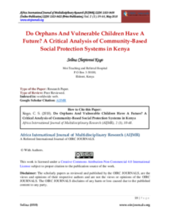Abstract
Globally, widespread increase of adversities such as chronic poverty and Hiv/Aids have increased the number of orphans and vulnerable children, thereby threatening the realization of the Sustainable Development Goals in spheres of Education, Health, Nutrition, and psychosocial development. In Kenya, the vulnerability of children communities is evident and its manifestation is in different spheres in the society causing disorder and disintegration. Orphans and vulnerable children have been the victims of circumstance, posing a big challenge to their survival and development. Academic evidence from various studies on child protection in other countries in Africa have shown how adoption of community based child protection mechanism can effectively address child protection issues. The main question is: Is this the same case in Kenya? With use of literature information in Kenya and outside, this paper analyses the role of community-based child protection structures for the survival and development of orphans and vulnerable children. Findings of the study indicates that there is disconnect that exist between the national child protection systems and community-based child protection structures thus, threatening the future of orphans and vulnerable children. The paper argues that Kenya has done little in strengthening community-based child protection systems, which play the role of prevention and coordination of resources at the community level in addressing child protection issues. Moreover, interventions employed by various stakeholders to establish and/or strengthen child social protection systems, have achieved little and are not sustainable. The paper concludes that community based child protection structures are fundamental instruments in prevention of children vulnerabilities and create a link between children, community and national structures. The paper recommends that for community-based protection structures to be effective, a creation of collaborative effort of these structures in addressing children vulnerabilities is integral.

